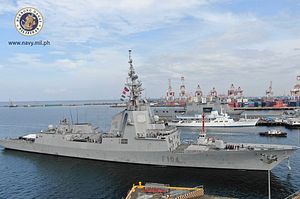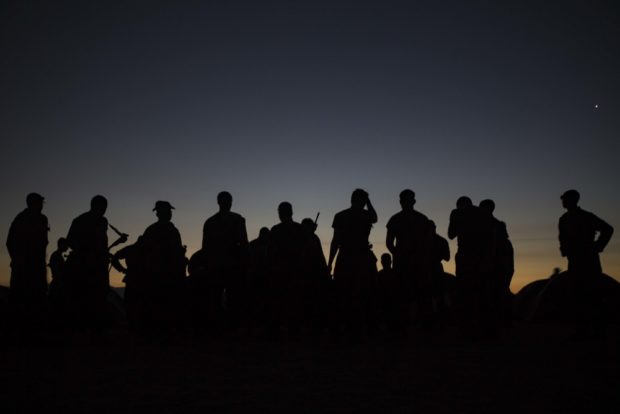
Indonesian Foreign Minister Retno Marsudi (right) looks on as Indonesian men La Utu bin Raali (left) and La Hadi bi La Adi receive hugs from their relatives days after they were released by suspected Abu Sayyaf bandits in the southern Philippines, Jan. 23, 2018. Handout/Indonesian Foreign Ministry/AFP
Malaysia has beefed up security near its maritime border with the southern Philippines, where recent kidnappings have taken place, in a move that will include the deployment of six light attack helicopters purchased from the United States, security officials said Friday.
Hazani Ghazali, chief of the Eastern Sabah Security Command (ESSCOM), said authorities arrested 41 undocumented Indonesia and Filipinos during raids on March 4 as part of a security operation codenamed “Ops Gasak,” which was aimed at disrupting cross-border criminal activities.
“Ops Gasak will neutralize the hotspot areas in ESSzone from any cross-border crimes,” Hazani said in a statement, using the acronym for the Eastern Sabah Safety Zone. “Our operations also work as deterrence.”
“ESSZone should be free from cross-border criminal activities which could disrupt the country's peace and harmony,” he said.
Security forces launched the operation in January, when they began checking immigration documents of people suspected to be working as “lookouts” for kidnap-for-ransom gangs in the region.
Among those captured in the security raids were men and women up to 65 years old, Hazani said in a statement, without elaborating.
During another operation early this month, authorities arrested a 47-year-old undocumented migrant from Indonesia, who was charged with illegal possession of a homemade shotgun and six 12-gauge cartridges, officials said.
The man was found hiding out in a palm oil plantation in Kalabakan, a district in Sabah state in Malaysian Borneo.
Authorities believe the “hotspots” in the region include “water villages,” which are floating communities or squatter settlements with houses on stilts.
Five operations conducted thus far at water villages in Sandakan, Kunak and Semporna districts led to the arrests of 723 undocumented migrants who were among 9,332 people interviewed by security officials.
Malaysia has yet to deport those arrested pending instruction from the National Security Council, officials told BenarNews.
Army confirms delivery schedule for helicopters
Six new light-attack helicopters, purchased by the Malaysian government under a U.S. $76 million contract inked in 2016, will be stationed in Sabah as part of the government’s move to bolster state’s security and reinforce anti-crime efforts in coastal areas, according to Army chief Gen. Hasbullah Mohd Nawawi.
The Muslim-majority nation will receive the first of six MD 530G helicopters this year and the military personnel who would be handling the choppers, euphemistically called “little birds,” would be sent for training in the United States, Hasbullah told reporters last week.
The remainder of the attack helicopters will be delivered in stages through 2021, he said.
“Once that is done, we will send the pilots for conversion training, followed by the maintenance crew to equip themselves with the know-how for the helicopters’ upkeep,” the New Straits Times quoted Hasbullah as saying.
Akhbar Satar, a director at the HELP University in Kuala Lumpur, told BenarNews that ESSCOM would need budgetary support to solve its security issues.
“It is high time Malaysia brings about an effective solution to the current dilemma,” he said. “If not, this terrible trend will continue again.”
Malaysian security authorities should set up a hostage-negotiation unit and follow the model used by the FBI in dealing with kidnapping scenarios, he said.
“The Behavioral Change Stairway Model developed by the FBI’s hostage-negotiation unit is an example of what we could follow. Besides techniques, crisis negotiations require a cool head and experience in hostage negotiation,” he told BenarNews.
In recent years, clashes between Filipino soldiers and suspected insurgents had caused criminals to cross over from the nearby southern Philippines into Sabah, from where they had planned criminal activities, including piracy and kidnappings, authorities said.
One such crime involved the kidnapping of five Indonesians who were believed seized within Sabah’s territorial waters on Jan. 16 by suspected members of the Abu Sayyaf, a group of bandits based in the southern Philippines.
About a week after the abductions, Philippine authorities said the captives and the gunmen were believed to be hiding in the jungles of an island off the coastal town of Parang in Sulu, in the southern Philippines.
Their fate remains unknown although news reports said their suspected abductors had attempted to demand ransom through a phone call.
In September last year, three Indonesian fishermen were also abducted from their boat off Sabah’s east coast.
Philippine officials announced in January that security forces rescued the third Indonesian fisherman weeks after authorities had rescued his two compatriots in southern Sulu province.
Earlier in the same month, Malaysian police said security forces gunned down two suspected Abu Sayyaf members during a shootout at sea off Sabah.
Abu Sayyaf is a militant group founded in the 1990s and notorious for kidnappings, bombings and beheadings of foreigners carried out in the southern Philippines during the past two decades. The group’s stronghold is in Jolo and Basilan islands in the southwestern part of the Philippines.
https://www.benarnews.org/english/news/malaysian/malaysia-philippines-03062020184117.html
Hazani Ghazali, chief of the Eastern Sabah Security Command (ESSCOM), said authorities arrested 41 undocumented Indonesia and Filipinos during raids on March 4 as part of a security operation codenamed “Ops Gasak,” which was aimed at disrupting cross-border criminal activities.
“Ops Gasak will neutralize the hotspot areas in ESSzone from any cross-border crimes,” Hazani said in a statement, using the acronym for the Eastern Sabah Safety Zone. “Our operations also work as deterrence.”
“ESSZone should be free from cross-border criminal activities which could disrupt the country's peace and harmony,” he said.
Security forces launched the operation in January, when they began checking immigration documents of people suspected to be working as “lookouts” for kidnap-for-ransom gangs in the region.
Among those captured in the security raids were men and women up to 65 years old, Hazani said in a statement, without elaborating.
During another operation early this month, authorities arrested a 47-year-old undocumented migrant from Indonesia, who was charged with illegal possession of a homemade shotgun and six 12-gauge cartridges, officials said.
The man was found hiding out in a palm oil plantation in Kalabakan, a district in Sabah state in Malaysian Borneo.
Authorities believe the “hotspots” in the region include “water villages,” which are floating communities or squatter settlements with houses on stilts.
Five operations conducted thus far at water villages in Sandakan, Kunak and Semporna districts led to the arrests of 723 undocumented migrants who were among 9,332 people interviewed by security officials.
Malaysia has yet to deport those arrested pending instruction from the National Security Council, officials told BenarNews.
Army confirms delivery schedule for helicopters
Six new light-attack helicopters, purchased by the Malaysian government under a U.S. $76 million contract inked in 2016, will be stationed in Sabah as part of the government’s move to bolster state’s security and reinforce anti-crime efforts in coastal areas, according to Army chief Gen. Hasbullah Mohd Nawawi.
The Muslim-majority nation will receive the first of six MD 530G helicopters this year and the military personnel who would be handling the choppers, euphemistically called “little birds,” would be sent for training in the United States, Hasbullah told reporters last week.
The remainder of the attack helicopters will be delivered in stages through 2021, he said.
“Once that is done, we will send the pilots for conversion training, followed by the maintenance crew to equip themselves with the know-how for the helicopters’ upkeep,” the New Straits Times quoted Hasbullah as saying.
Akhbar Satar, a director at the HELP University in Kuala Lumpur, told BenarNews that ESSCOM would need budgetary support to solve its security issues.
“It is high time Malaysia brings about an effective solution to the current dilemma,” he said. “If not, this terrible trend will continue again.”
Malaysian security authorities should set up a hostage-negotiation unit and follow the model used by the FBI in dealing with kidnapping scenarios, he said.
“The Behavioral Change Stairway Model developed by the FBI’s hostage-negotiation unit is an example of what we could follow. Besides techniques, crisis negotiations require a cool head and experience in hostage negotiation,” he told BenarNews.
In recent years, clashes between Filipino soldiers and suspected insurgents had caused criminals to cross over from the nearby southern Philippines into Sabah, from where they had planned criminal activities, including piracy and kidnappings, authorities said.
One such crime involved the kidnapping of five Indonesians who were believed seized within Sabah’s territorial waters on Jan. 16 by suspected members of the Abu Sayyaf, a group of bandits based in the southern Philippines.
About a week after the abductions, Philippine authorities said the captives and the gunmen were believed to be hiding in the jungles of an island off the coastal town of Parang in Sulu, in the southern Philippines.
Their fate remains unknown although news reports said their suspected abductors had attempted to demand ransom through a phone call.
In September last year, three Indonesian fishermen were also abducted from their boat off Sabah’s east coast.
Philippine officials announced in January that security forces rescued the third Indonesian fisherman weeks after authorities had rescued his two compatriots in southern Sulu province.
Earlier in the same month, Malaysian police said security forces gunned down two suspected Abu Sayyaf members during a shootout at sea off Sabah.
Abu Sayyaf is a militant group founded in the 1990s and notorious for kidnappings, bombings and beheadings of foreigners carried out in the southern Philippines during the past two decades. The group’s stronghold is in Jolo and Basilan islands in the southwestern part of the Philippines.
https://www.benarnews.org/english/news/malaysian/malaysia-philippines-03062020184117.html













